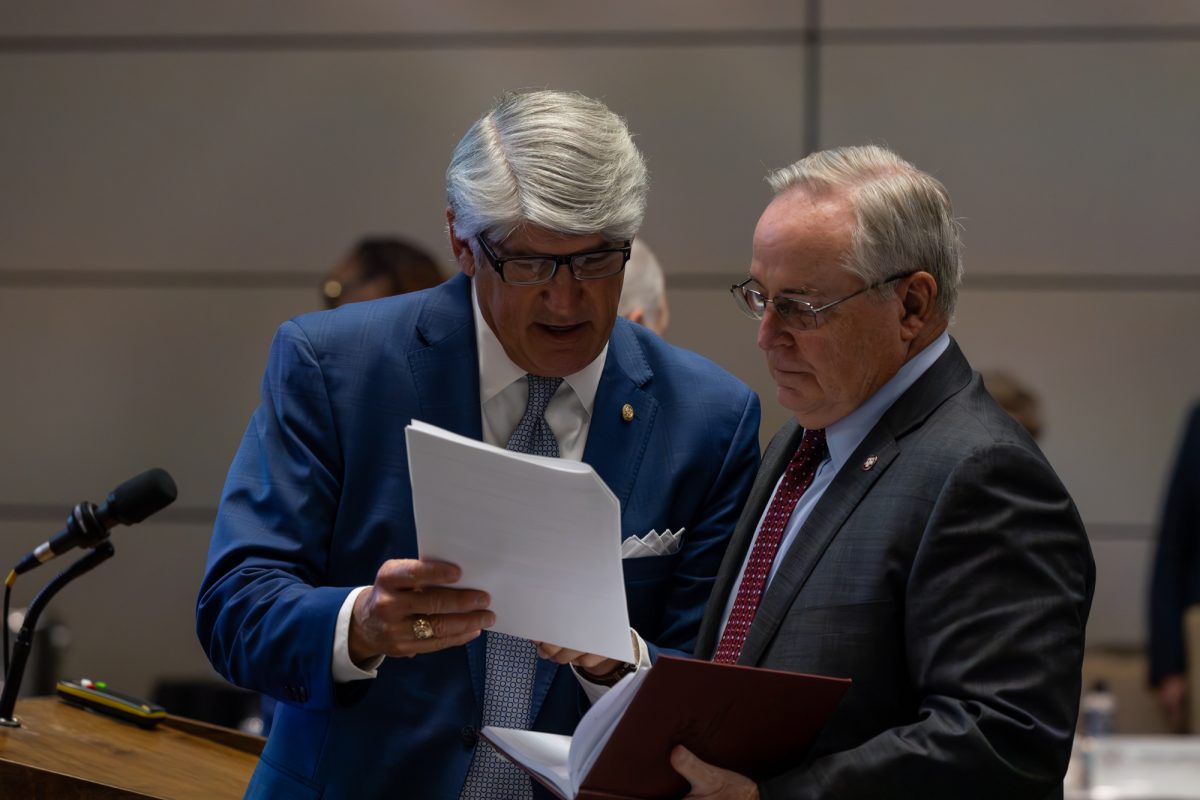Halfway through the Fall 2017 semester, Texas A&M has faced the wrath of Hurricane Harvey, anxiety over immigration policy, concerns about free speech and a host of challenges tied to the university’s ever-increasing size.
The semester’s tumultuous first half has presented a unique set of challenges for student leaders as they work to build and maintain student representation at the higher levels of university decision-making. On Oct. 31, student leaders will speak with University President Michael Young during their first formal meeting of the semester, presenting student perspectives on the issues shaping A&M’s campus and community.
While student leaders will be entering the meeting with half a semester’s worth of topics to discuss, Memorial Student Center President Annie Carnegie said previous opportunities to exchange ideas with Young have been invaluable to fostering understanding between the administration and student body.
“I think that when we go into a meeting, we definitely feel like we leave with a better understanding of the university and that President Young is able leave with a better understanding of what’s going on with the student body,” Carnegie said.
Though schedules have been strained by the extra commitments a chaotic semester brings, Student Body President Bobby Brooks said Young remains committed to understanding students’ concerns, taking time to speak with student leaders at other events and gatherings throughout the semester.
“I do get to run into him quite frequently, so whenever I do bump into him, I bring up a lot of the ideas I have and a lot of those things I’ve been working on and I really try to get in as much time with him as I possibly can,” Brooks said. “He will listen to me when I track him down, he’ll talk and he does offer good suggestions and tips.”
However, the settings of these unstructured meetings with the president can sometimes restrict the range of topics that can realistically be discussed, said Matthew Etchells, president of Graduate and Professional Student Council, recalling a conversation with Young at the Aggie football game against South Carolina.
“In that setting, you’re not going to say something that would lead to a deep conversation, you kind of keep it light because that is the social norm for those kind of spaces,” Etchells said.
More consistent, scheduled contact with A&M’s administration comes through regular meetings with Daniel Pugh, executive vice president for student affairs, said Jasmine Wang, speaker of the student senate.
“I get regular meetings with Dr. Pugh and that kind of helps to supplement that because Dr. Pugh will usually take whatever we discuss to President Young, but I think that it would also really help just to establish that relationship with President Young so that he also is more in tune with what the students are doing in the Student Government Association,” Wang said.
Though student leaders recognize the importance of coordinating with a larger variety of university officials to serve the student-body’s interests, Wang said navigating the complex structure of university leadership can often present additional barriers.
“I wish that we had more resources so, as students, we know who to go to about specific issue because I think that there’s so much bureaucracy sometimes that it gets very confusing and very difficult to get in contact with the right people,” Wang said. “So there’s definitely improvements to be made on both ends.”
Even as student leaders and university officials work together to address the concerns of students, Brooks said the greater challenge is often making sure the student perspective is considered in major decisions made by the Board of Regents.
“The administration does as much as they can and they really do care about the students,” Brooks said. “The problem comes in at higher decision making levels in terms of the disconnect between students and what goes on at the university.”
The Board of Regents, which oversees the overall direction and development of the A&M System’s 11 universities and seven state agencies, includes the position of student regent — a non-voting member of the board selected through the approval of A&M’s student government, Chancellor John Sharp and of ultimately Gov. Greg Abbott. Current Student Regent Stephen Shuchart said his position involves constant contact with the university officials and student representatives of each system school.
“Since I do not have a vote, I’m not able to directly influence the policy of the system,” Shuchart said. “However, I’m there as kind of a conduit and middleman for the regents to be able to hear directly from the student voice and directly from student leaders and to hear their opinion on issues and then hopefully they’ll be able to take that into account in reflection of their decisions.”
Though many student concerns involve issues that are primarily handled at the university level, Shuchart said he works to recognize the broader, system-wide issues that students care about and ensure that their perspective is presented.
“I’ll be sure to bring up student concerns and say ‘hey, I’ve spoken with student leaders on campus and this is how they feel about this project or this initiative,’” Shuchart said.
When trying to make sure that student’s voices are continuously heard at the university’s highest levels of authority. Shuchart said one of the greatest challenges is working within the relatively short time-frame of a student’s 4-year education.
“I think at the end of the day the biggest problem in developing those relationships is the natural turnover there is in higher education,” Shuchart said. “Every four years, you’re going to get a majority of new students and the majority of students are going to leave.”
As the academic year goes by, Shuchart said student leaders gain a better sense of how to effectively coordinate with each other and build stronger relationships between students, administration and the Board of Regents. This level of continuous, open communication helps form a more united response to issues like Hurricane Harvey, the repeal of DACA and the proposed white nationalist rally on the A&M campus.
“I think that the way these issues were handled, they were handled tremendously, but I think had these events occurred in the spring, they would have been handled even more incredibly well because there was that time to build those relationships and develop the institutional memory,” Shuchart said.
Creating a conversation
October 20, 2017
Photo by Photo by Cassie Stricker
Texas A&M President Michael Young sings the War Hymn with students at the first Midnight Yell of the year.
0
Donate to The Battalion
$2065
$5000
Contributed
Our Goal
Your donation will support the student journalists of Texas A&M University - College Station. Your contribution will allow us to purchase equipment and cover our annual website hosting costs, in addition to paying freelance staffers for their work, travel costs for coverage and more!
More to Discover










